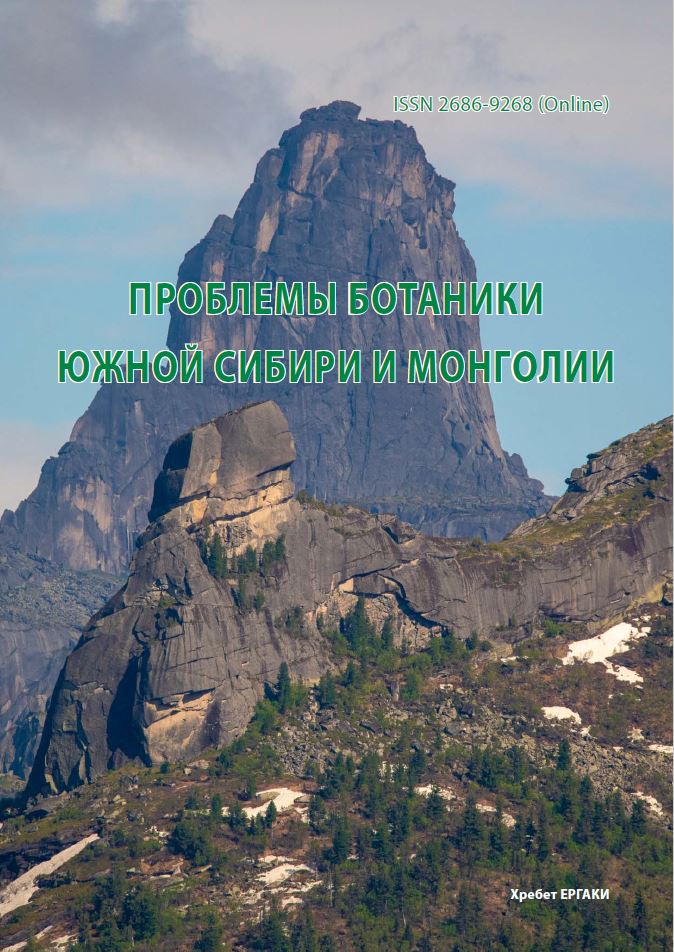Anatomical and morphological study of the roots of species of the genus Iris from natural populations of southeastern Kazakhstan
УДК 582.579.2:581.43:581.4+581.8(574.4)
Abstract
Wild-growing species of the genus Iris L. are perennial rhizomatous plants better known for decorative properties and promising plants as sources of medicinal raw materials. Irises contain essential oil, isoflavones, flavonoids, carotenoids, various organic acids, and tannins. The rhizomes of some irises have an immunomodulatory, anti-inflammatory, antioxidant, tonic effect, exhibit antiviral, acaricidal, antifungal activity. Medicinal and ornamental properties characterized by six species I. alberti, I. lactea, I. ruthenica, I. sogdiana, I. songarica, I. tenuifolia out of 11 irises from southeast of Kazakhstan which grow within Almaty administrative region in different ecological conditions (from foothills and mountain slope North Tian Shan up to steppe zones of Balkhash Alakol basin). The objects of research were 3 wild species of Iris L., growing in the southeast of Kazakhstan. The goal of this research is a comparative anatomical and morphological study of the roots of species Iris alberti Regel (1, 2 populations), I. pallasii Fisch. ex Trevir., I. sogdiana Bunge from natural populations of southeastern Kazakhstan. Field studies of wild populations of the Iris species were carried out by the route-reconnaissance method. Geobotanical methods were used to describe plant communities with the participation of research objects. Microscopic studies of the roots were carried out by conventional procedure. As a result of the anatomical and morphological study, we found that pronounced mesophytic features of the anatomical structure of the plant species are associated with an increase in the diameter of the central cylinder and the diameter of the xylem vessels. The highest degree of development of conducting tissue indicates an increased moisture gradient. The pronounced thickness of the primary cortex indicates the presence of xerophytic features of the anatomical structure. These results indicate the relationship between the ecological conditions of the studied Iris species growth and features of a primary anatomical structure of its root.
Downloads
Metrics
References
Абдулина С. А. Список сосудистых растений Казахстана / под ред. Р. В. Камелина. - Алматы, 1999. - С. 106-107.
Аннотированный список лекарственных растений Казахстана: Справочное издание / Л. М. Грудзинская, Н. Г. Гемеджиева, Н. В. Нелина, Ж. Ж. Каржаубекова. - Алматы, 2014. - С. 86-87.
Базарнова Н. Г., Тихомирова Л. И., Синицына А. А., Афанасенкова И. В. Сравнительный анализ химического состава растительного сырья Iris sibirica L. // Химия растительного сырья, 2017. - №4. - С. 137-144.
БайковаЕ. В., Доронькин В. М. Анатомическое строение корней сибирских видов рода касатик Iris L., подрода Iris (Iridaceae) // Вестн. Том. гос. ун-та, 2009. - №319. - C. 186-190.
Байтенов М. С. Флора Казахстана в 2-х т. - Т. 2. Родовой комплекс флоры. - Алматы: Fbrnbrn, 2001. - C. 54.
Барыкина Р. П., Веселова Т. Д., Девятов А. Г. Справочник по ботанической микротехнике. - М.: МГУ, 2004. -313 с.
Быков Б. А. Геоботаника. - Алма-Ата: Изд-во АН КазССР, 1957. - С. 22-23.
Государственная фармакопея СССР, XI изд., вып. 1. - М.: Наука, 1987. - 334 с.
Государственная фармакопея СССР, XI изд., вып. 2. - М.: Наука, 1990. - 50 с.
Дикорастущие полезные растения России / Отв. ред. А. Л. Буданцев, Е. Е. Лесиовская. - СПб: Издательство СПХФА., 2001. - С. 320.
Корчагин А. А. Видовой (флористический) состав растительных сообществ и методы его изучения // Полевая геоботаника. - Т. 3. - М.-Л., 1964. - С. 39-60.
Иващенко А. А., Казенас О. Д., Бобровский В. П. Касатик Альберта // Красная книга Казахстана. Изд. 2-е, переработанное и дополненное. - Т. 2: Растения (колл. авторов). - Астана, ТОО «АртPrintXXI», 2014. - С. 335.
Пермяков А. И. Микротехника. - М.: МГУ, 1988. - 58 с.
Плантариум. Растения и лишайники России и сопредельных стран: открытый онлайн атлас и определитель растений. Iris pallasii Fisch. ex Trevir. URL: https://www.plantarium.ru/page/view/item/20789.html (Дата обращения 24 мая 2023).
Плантариум. Растения и лишайники России и сопредельных стран: открытый онлайн атлас и определитель растений. Iris sogdiana Bunge. URL: https://www.plantarium.ru/page/view/item/20820.html (Дата обращения 25 мая 2023 г.).
Поляков П. П. Семейство Касатиковые - Iridaceae Lindl. // Флора Казахстана / под ред. Н. В. Павлова. - Т. 2. -Алма-Ата: Изд-во Академии наук Казахской ССР, 1958. - С. 232-246.
Понятовская В. М. Учет обилия и особенности размещения видов в естественных растительных сообществах // Полевая геоботаника. - Т. 3. - М.-Л., 1964. - С. 209-237.
Прозина М. Н. Ботаническая микротехника. - М.: МГУ, 1960. - 260 с.
Рамазанова М. С., Курбатова Н. В., Гемеджиева Н. Г., Алдасугурова Ч. Ж. Анатомо-морфологические особенности ирисов юго-восточного Казахстана // Вестник КарГУ Серия биология, медицина, география, 2020 -№3(99). - С. 109-118. DOI: 10 31489/2020BMG3/109-118
Растительные ресурсы России: Дикорастущие цветковые растения, их компонентный состав и биологическая активность. Семейства Butomaceae - Typhaceae / под ред. А. Л. Буданцева. - Т. 6. - СПб.; М.: Тов-во науч. изд. КМК, 2014. - С. 41-43.
Растительные ресурсы России и сопредельных государств. Цветковые растения, их химический состав, использование: семейства Butomaceae - Typhaceae / отв. ред. Соколов П. Д. - СПб.: Наука, 1994. - C. 77-82.



